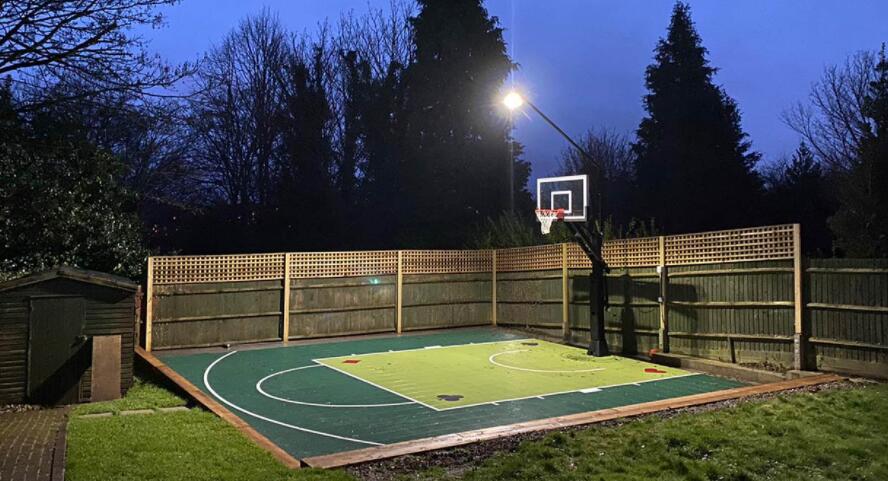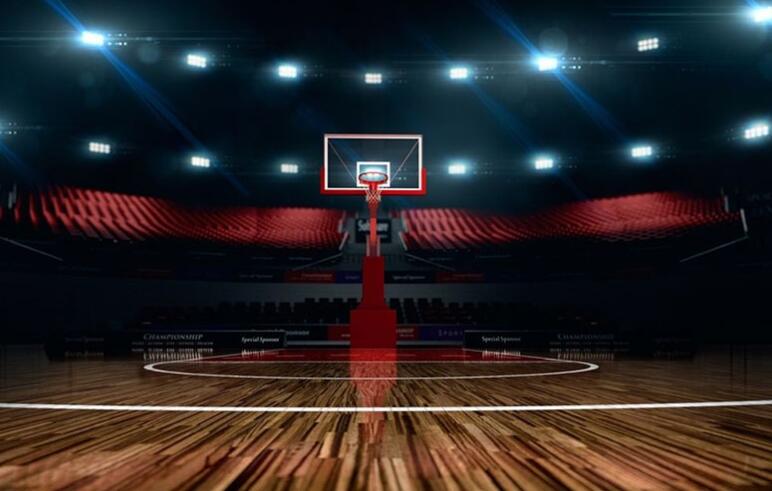Whether collegial or mainstream, basketball remains one of the most popular sports around the world. It also presents the flexibility of either outdoor or indoor play. If you ever went to a live basketball game, one thing that stands out is the lighting.
No matter where you sit, you will always get a good scope of the angles and it is due to the great lightning.
As you read on, you will learn more about what makes the basketball lighting system stand out among other sports and some suggestions about basketball court lighting design.

What Lights Are Used in the Basketball Court and Stadium?
The lights have delicate considerations because the wrong ones could block the players’ or spectators’ vision.
Averagely, the recommendation is around 200 lux per square meter.
A standard basketball court is about 4700 square feet which are 437 square meters; doing the math shows that you need about 87400 lumens for a standard court.
To attain the right level of illumination, you need at least 583 watts of LED power.
This is a rough estimation of how much power you would need, although there may be slight variations depending on preferences.
Several brands decide to opt for 300 watts LED floodlights.
Asides from the lights, some underlying factors are very important just like the lux level; let’s have a look at them briefly:
1. Anti-Glare: You know the feeling you get after staring into your computer screen for a long. If the stadium lights are not anti-glare, both players and spectators would feel eye discomfort over time. Every light must be anti-glare.
2. Television Standard: In case you were not aware, there is a minimum lighting requirement for televised games. If the court is going to air broadcasted matches, then they have to meet up to the minimum standard of 2000 lux. Asides from the lux, it must have a color temperature within 5500 to 6000k, Color Rendering Index (CRI) of 90, and a maximum to minimum lux ratio of 0.5.
3. IP Rating and Surge Protection: Surge protection is one major thing that many do not prioritize. The reason why you don’t see lights blowing up in a live basketball game is because of the surge protection. It is best to get LEDs with surge protection in case of high voltage. An IP65 rating is also important to ensure the longevity of the lights.
4. Flicker Standard: Technological advancement in cameras makes it very easy to detect flickers. To avoid such, the lightning should have a flicker rate below 0.3%. It is a threshold in which the best camera can’t detect.
Outdoor Basketball Court Lighting Design
Getting the recommended LEDs is not enough when considering your lighting. The positioning to reduce glare and reflections is also important.
Let’s have a look at the designs for both half and full outdoor court:
How to Light up an Outdoor Half Basketball Court?
Half Basketball courts are mostly for recreational and practice purposes so you do not need much extra lighting.
Here are a few things you can factor in:
1. Light Poles
Half court does not need excessive illumination; two poles will be sufficient. Their positioning should be just around the halfway line.
From the half-line, it will reflect to the whole court; if you wish to make it four poles, then each of them should be close to the corners.
2. Pole Height
Due to the fact that the court is not so big you don’t need tall poles; they can be just a little taller than the hoop.
Shorter poles on half-court won’t only provide better illumination but also require weaker light which would consume less power and save more cost.
However, if for some reason, you plan to use the half-court for televised event, then you could consider using higher poles and stronger lights.
How to Light up an Outdoor Full Basketball Court?
Since it is bigger and most likely for main scale media, here are considerations for your outdoor full basketball court:
1. Light Poles
Obviously, the number of light poles is a major determinant of how well illuminated your basketball court will be; it is usually between 4 to 8 light poles.
To get the best from a full-court, you should use at least 6 poles.
If there are six poles, then there will be two adjacent ones in the center of the court.
The positioning doesn’t also change so they should not be at the backcourt but by the sides.
Generally, you need at least 2 poles each in both halves of the court. For a total of four poles, then two poles should be adjacent to each other around the middle of each half.
For the best lighting, which is 8, it will be four poles in each half.
However, it also depends on how many outdoor courts you are illuminating.
If you have up to 3 or 4 courts beside each other, you only need one light pole each by the sides as they will reflect into each court.
Not only will it save energy, it will also save you the cost.
2. Height of Pole
Although there is a set specification for the height of the poles, you can choose to go for short or taller poles.
Shorter poles will allow you to use fewer LEDs. Longer poles will require stronger light which may consume more power.
However, the shorter ones will need more maintenance and frequent replacement. In the long run, long pole will pay off cost wise.
3. Light Positioning
Light Positioning is highly dependent on the number of poles you are using and how many courts are lined side by side.
For a typical full outdoor court, four poles will work effectively. The positioning should be by the side of the court, near each corner.
If the lightning is for more than one court, then you need a luminaire ring with them.
If you want better illumination, then you can go for the 6 pole layout. The additional two poles will be around the center line.
However, if your full outdoor basketball court is only for training, you may not need as much as four; two would be okay since you don’t need excessive illumination.
4. Beam Angle for Lights
Since it is a direct lighting system, it has to be in a position that reduces glare and reflection into the eyes of players.
In terms of the tilt, you can go as much as 120 degrees but 70 degrees is the recommended threshold.
You also need to consider the pole heights because lower heights will require higher beam angles.
Indoor Basketball Court Lighting Design
An indoor court can’t have the same design as the outdoor variant for several reasons.
Apart from the fact that indoor structures cannot house huge poles, the polished wood floor is also highly reflective.
So when designing the lighting of an indoor court, glare and reflection are the two major factors.
Here are the directives:

1. Direct Lighting
Here you allow most of the light to fall directly on the court. This design is for maximum illumination but there is not much sophistication to it.
The lightings are fastened to the roof and they beam directly on the court.
It is the best design for televised games as everything comes out sharp.
2. Indirect Ligting
If you feel that the direct lighting provides too much glare or reflection, then this is for you.
Rather than having the light fall directly on the court, you turn them to face the roof, which in turn reflects the light to the court.
However, if you want this is come out beautiful, you need more powerful LEDs.
The merit of this system is that it eliminates shadows and the light spreads out more efficiently rather than beaming down powerfully.
The anesthetic appeal that it presents is unmatched; if hit wish for the best results, then you can combine the direct and indirect lighting on the same court.
3. Light Spacing
You need to provide optimal spacing if you want the most uniform illumination. It can vary depending on how high the ceiling is, but you could also deduce half of the ceiling height to get an approximation.
When spacing, you should also be careful that the lights are not close to the walls. The light would reflect off the wall and make the ceiling shorter than it really is.
Provided that you follow the lux standard for the LEDs, you won’t have any issues with spacing.
4. Amount of High Bay Lights
There are several ways to know how much light you should use. The most effective is to use DIALux software.
However, non-professionals may find it difficult to navigate the interface so you may need a lighting designer to help out.
Such individuals will let you know how many high bay lights you need, also corresponding to the lux requirements.
To sum up:
Due to the polished wood, the lighting of the indoor basketball court is a bit more delicate.
Polished wood is a reflective surface and wrong positioning would have a light reflection from the floor affecting both players and spectators.
The lightning would be at the top, however, to reduce reflection, not all should be pointing directly downwards.
It is commonly called indirect lighting. For indirect lighting, you point the ceiling lamps upwards, so they reflect off the ceiling.
The only issue with the indirect method is that the ceiling absorbs most of the light.
To avoid such, most stadiums employ side arrangements of the lamps to compensate for the ones facing upwards. Some others combine direct, side, and indirect lighting.
Whichever method you employ, ensure that all lamps comply with the lux, color temperature, and CRI standards.
How Much Will Basketball Court Lighting Cost?
At first, the overall cost may seem a bit expensive, but because it lasts for a very long time, it is worth the price. Since the standard is 2000 lux, it will require about 7000 Watt LEDs.
To get the hourly estimation, you multiply by $0.12 and divide by 1000 which gives $0.84 per hour.
It then depends on how long you turn on the lights in a day. If you power them for 10 hours per day, the math gives you $8.4 for the day.
If the 10 hours is consistent then it would yield about $252 per month. This is only to give you a rough idea of the price as there may be a slight price variation.
If you think it is a bit on the high side then you should have a little rethink.
Getting other alternatives like halogen bulbs which consume more power would be more expensive in multiple folds.
Conclusion
The need for proper lighting in a basketball court cannot be underestimated, especially if it is for televised events.
However the price may seem, it would be well worth it in the long run.
That being said, you have all you need to make your court a well-lit place.
